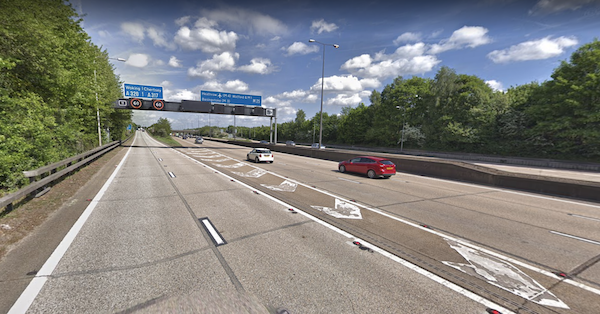Everett v Dyer 2019
 Summary
Summary
Riding at 100mph prior to the incident results in 25% contributory negligence due to causative potency.
Background
At approximately 8.05am on 21st April 2017, a serious road traffic collision occurred on the North-Westbound slip road at junction 11 of the M25 motorway near Chertsey, Surrey.
A white Ford Transit 'Luton' 3.5 tonne van being driven by the defender left the M25 motorway at junction 11 and travelled along the two lane slip road towards traffic lights positioned at the end of that slip road. The pursuer, riding a Yamaha MT motorcycle, left the M25 some distance behind the white van at the same junction and also proceeded along the same slip road.
As the motorcyclist approached the van, the driver manoeuvred his van from the second or offside lane ("lane 2") in which there was a long line of slow moving or stationary traffic in order to take up a position in the left or nearside lane of the slip road ("lane 1") which was free or virtually free of traffic.
Within a few seconds of the commencement of the van driver’s manoeuvre, the motorcyclist collided with the rear of the van and came to a sudden halt.
The issues
Pursuer (Motorcyclist)
As the motorcyclist approached the rear of the van, it suddenly moved from lane 2 into lane 1 and into his path. It was argued that the van driver had made this manoeuvre without checking properly or at all to the rear of his van and without indicating his intention to do so.
As a result, the motorcyclist had been unable to stop safely and instead his hard braking had caused a ‘stoppie’ (rear wheel lifting) which had catapulted him onto the rear of the van.
Defender (Van Driver)
The van driver argued that he had decided to move from lane 2 into lane 1 due to the long line of stationary or slow-moving traffic ahead of him. He had checked his wing mirrors, indicated to move left, checked his mirrors again and then moved out slowly. He argued that the motorcyclist was at no time visible in his mirrors, despite careful checks.
In the course of the trial, it was contended that the cause of the incident was that the motorcyclist had ridden his motorcycle too fast and in an erratic manner.
Decision
After hearing evidence from both experts in collision reconstruction, Police officers, the van driver, motorcyclist and a witness the judge found that;
• The van driver had checked his wing mirror once, indicated his intention to move by switching on the left-hand indicator and fleetingly checked the nearside wing mirror again as he began to emerge from lane 2 into lane 1.
• At the first mirror check, the motorcycle was capable of being seen as long as the mirror check was undertaken carefully.
• That what ought to have been a second and careful mirror check (but which was probably a fleeting check at the moment the van commenced its manoeuvre) the motorcycle was entirely capable of being seen. In his judgement, the motorcycle was approximately 52-60m from the rear of the van and travelling at approximately 60 mph at this moment in time.
• If the motorcycle had been seen by the van driver at the first or, alternatively, at the second mirror check, the manoeuvre ought to have been postponed until it was safe to emerge.
Judgement
The judge found that the principle cause of the collision had been the emergence of the van from lane 2 of the slip road into the lane 1 which had caused a clear, immediate and, in the event, insuperable obstacle to the pursuer’s approaching motorcycle.
Contribution to the incident by the pursuer
When assessing the motorcyclist’s own contribution to the incident, the judge found as a matter of fact that;
• The motorcyclist had initially been travelling along the slip road at or slightly above 100 mph.
• Whilst speed, of itself, does not necessarily imply negligence, it is self-evident that travelling at such a speed allows a rider significantly less time and opportunity to deal with an arising hazard or obstacle.
• The motorcyclist had been travelling at more than twice the safe and reasonable speed at which it ought to have been travelling.
• The motorcycle decreased its speed under engine compression and had been travelling at a speed of approximately 75 mph at a point in time less than two seconds prior to the commencement of the van's manoeuvre.
• The motorcycle had been travelling too fast and therefore offered its rider little chance of avoiding a collision once the obstacle had appeared in his path.
When attributing blame to the motorcyclist, the judge considered the principle of ‘causative potency’ and concluded that the potency of the defender’s manoeuvre was far greater than the potency of pursuer’s speed.
The van driver could and should have made careful observations and seen the approach of the motorcyclist.
There was a significant destructive disparity between the van and the motorcycle. The obstacle and hazard arose principally because of the movement of the van from lane 2 towards lane 1.
The apportionment of blame to the motorcyclist for the incident was 25%.